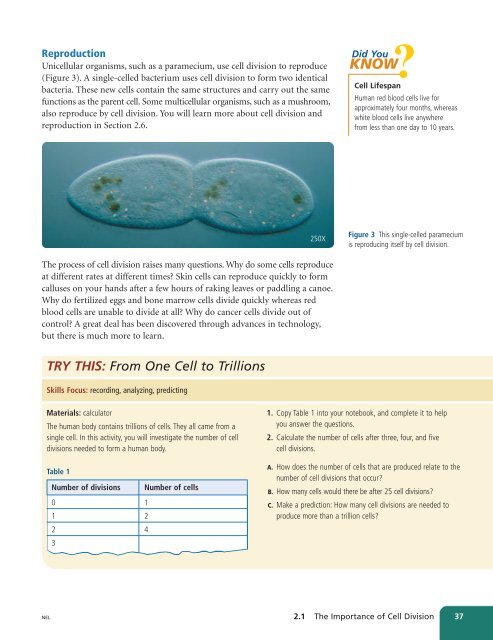Unit A Reproduction
Unit A Reproduction
Unit A Reproduction
You also want an ePaper? Increase the reach of your titles
YUMPU automatically turns print PDFs into web optimized ePapers that Google loves.
<strong>Reproduction</strong><br />
Unicellular organisms, such as a paramecium, use cell division to reproduce<br />
(Figure 3). A single-celled bacterium uses cell division to form two identical<br />
bacteria. These new cells contain the same structures and carry out the same<br />
functions as the parent cell. Some multicellular organisms, such as a mushroom,<br />
also reproduce by cell division. You will learn more about cell division and<br />
reproduction in Section 2.6.<br />
Did You<br />
KNOW?<br />
Cell Lifespan<br />
Human red blood cells live for<br />
approximately four months, whereas<br />
white blood cells live anywhere<br />
from less than one day to 10 years.<br />
250X<br />
Figure 3 This single-celled paramecium<br />
is reproducing itself by cell division.<br />
The process of cell division raises many questions. Why do some cells reproduce<br />
at different rates at different times? Skin cells can reproduce quickly to form<br />
calluses on your hands after a few hours of raking leaves or paddling a canoe.<br />
Why do fertilized eggs and bone marrow cells divide quickly whereas red<br />
blood cells are unable to divide at all? Why do cancer cells divide out of<br />
control? A great deal has been discovered through advances in technology,<br />
but there is much more to learn.<br />
TRY THIS: From One Cell to Trillions<br />
Skills Focus: recording, analyzing, predicting<br />
Materials: calculator<br />
The human body contains trillions of cells. They all came from a<br />
single cell. In this activity, you will investigate the number of cell<br />
divisions needed to form a human body.<br />
Table 1<br />
Number of divisions<br />
0 1<br />
1 2<br />
2 4<br />
3<br />
Number of cells<br />
1. Copy Table 1 into your notebook, and complete it to help<br />
you answer the questions.<br />
2. Calculate the number of cells after three, four, and five<br />
cell divisions.<br />
A. How does the number of cells that are produced relate to the<br />
number of cell divisions that occur?<br />
B. How many cells would there be after 25 cell divisions?<br />
C. Make a prediction: How many cell divisions are needed to<br />
produce more than a trillion cells?<br />
NEL<br />
2.1 The Importance of Cell Division 37

















